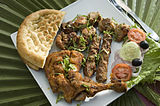Biryani
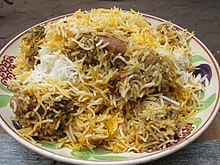 Hyderabadi biryani | |
| Alternative names | Biriyani, Biriani, Beriani, Briyani, Breyani, Briani, Birani, Buriyani, Bariania |
|---|---|
| Course | Main dish |
| Region or state | Indian subcontinent, Western Asia, Central Asia, Southeast Asia, Southern Africa |
| Serving temperature | Hot |
| Main ingredients |
|
| Ingredients generally used |
|
| Variations | Various |

Biryani (/bɪrˈjɑːni/) is a mixed rice dish originating among the Muslims of the Indian subcontinent.[1][2][3] It is made with Indian spices, rice, and meat usually that of chicken, goat, lamb, prawn, fish, and sometimes, in addition, eggs or vegetables such as potatoes in certain regional varieties.[4]
Biryani is popular throughout the Indian subcontinent, as well as among the diaspora from the region. It has gained popularity in South India especially in Tamil Nadu, Andhra Pradesh and Telangana. It is also prepared in other regions such as Iraqi Kurdistan.[5]
Etymology[]
Biryani is an Indo-Aryan word derived from the Persian language, which was used as an official language in different parts of medieval India by various Islamic dynasties.[6][7] One theory states that it originated from birinj (Persian: برنج), the Persian word for rice.[8][9] Another theory states that it is derived from biryan or beriyan (Persian: بریان), which means "to fry" or "to roast".[10][11]
Origin[]
The exact origin of the dish is uncertain. In North India, different varieties of biryani developed in the Muslim centres of Delhi (Mughlai cuisine), Rampur, Lucknow (Awadhi cuisine) and other small principalities. In South India, where rice is more widely used as a staple food, several distinct varieties of biryani emerged from Hyderabad Deccan (where some believe the dish originated[12]) as well as Tamil Nadu (Ambur, Thanjavur, Chettinad, Salem, Dindigal), Kerala (Malabar), Telangana, and Karnataka (Bhatkal) where Muslim communities were present.[8][13]
According to historian Lizzie Collingham, the modern biryani developed in the royal kitchens of the Mughal Empire (1526–1857) and is a mix of the native spicy rice dishes of India and the Persian pilaf.[14] Indian restaurateur Kris Dhillon believes that the dish originated in Persia, and was brought to India by the Mughals.[15]
Another theory claims that the dish was prepared in India before the first Mughal emperor Babur conquered India.[16] The 16th-century Mughal text Ain-i-Akbari makes no distinction between biryanis and pilaf (or pulao): it states that the word "biryani" is of older usage in India.[17] A similar theory, that biryani came to India with Timur's invasion, appears to be incorrect, because there is no record of biryani having existed in his native land during that period.[16]
According to Pratibha Karan, who wrote the book Biryani, biryani is of South Indian origin, derived from pilaf varieties brought to the Indian subcontinent by Arab traders. She speculates that the pulao was an army dish in medieval India. Armies would prepare a one-pot dish of rice with whichever meat was available. Over time, the dish became biryani due to different methods of cooking, with the distinction between "pulao" and "biryani" being arbitrary.[8][16]
According to Vishwanath Shenoy, the owner of a biryani restaurant chain in India, one branch of biryani comes from the Mughals, while another was brought by the Arab traders to Malabar in South India.[18]
There are various apocryphal stories dating the invention to Shah Jahan's time but Rana Safvi, the distinguished historian, says she could only find a recipe from the later Mughal period, from Bahadur Shah Zafar's time. It is not her claim that there was no biryani before that; just that she has not found a recipe. Other historians who have gone through texts say that the first references to biryani only appear around the 18th century.[19]
Difference between biryani and pulao[]

Biryani contains more gravy and is cooked longer with condiments
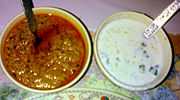
Two biryani accompaniments, mirchi ka salan and raita
Pilaf or pulao, as it is known in the Indian subcontinent, is another mixed rice dish popular in the cuisines of the Indian subcontinent, Central Asia, and Middle Eastern cuisine. Opinions differ on the differences between pulao and biryani, and whether actually there is a difference between the two.[20]
According to Delhi-based historian Sohail Hashmi, pulao tends to be plainer than biryani, and consists of meat or vegetables cooked with rice. Biryani contains more gravy (due to the use of yakhni), and is often cooked longer, leaving the meat (and vegetables, if present) more tender. Biryani is also cooked with additional dressings.[21]
Pratibha Karan states that while the terms are often applied arbitrarily, the main distinction is that a biryani consists of two layers of rice with a layer of meat (and vegetables, if present) in the middle, while the pulao is not layered.[16]
Colleen Taylor Sen lists the following distinctions between biryani and pulao:[22]
- Biryani is the primary dish in a meal, while the pulao is usually a secondary accompaniment to a larger meal.
- In biryani, meat (and vegetables, if present) and rice are cooked separately before being layered and cooked together. Pulao is a single-pot dish: meat (or vegetables) and rice are simmered in a liquid until the liquid is absorbed.However, some other writers, such as Holly Shaffer (based on her observations in Lucknow), R. K. Saxena and Sangeeta Bhatnagar have reported pulao recipes in which the rice and meat are cooked separately and then mixed before the dum cooking.[20][23]
- Biryanis have more complex and stronger spices compared to pulao. The British-era author Abdul Halim Sharar mentions the following as their primary difference: biryani has a stronger taste of curried rice due to a greater amount of spices.[20][24]
Ingredients[]
Ingredients for biryani vary according to the region and the type of meat and vegetables used. Meat (of either chicken, goat, beef, lamb,[25] prawn or fish) is the prime ingredient with rice. As is common in dishes of the Indian subcontinent, vegetables are sometimes also used when preparing biryani. Corn may be used depending on the season and availability. Navratan biryani tends to use sweeter, richer ingredients such as cashews, kismis and fruits, such as apples and pineapples.[21]
The spices and condiments used in biryani may include ghee (clarified butter), nutmeg, mace,[26] pepper, cloves,[26] cardamom, cinnamon, bay leaves, coriander, mint leaves, ginger, onions, tomatoes, green chilies,[27] and garlic. The premium varieties include saffron.[26]
The main ingredient that usually accompanies the spices is chicken or goat meat; special varieties might use beef or seafood instead. The dish may be served with dahi chutney or raita, korma, curry, a sour dish of aubergine (brinjal), boiled egg, and salad.
Preparation styles: pakki versus kacchi biryani[]
Biryani can be cooked using one of two styles/techniques, pakki ("cooked") and kacchi ("raw").
- In a pakki biryani, the rice, marinated meat, and any vegetables are partially ("three-quarters") cooked separately, before being combined into layers in a cooking vessel. Different layers of rice may be treated with different spices (e.g., with dissolved saffron or turmeric give the rice different colors and flavors).The contents are then baked to complete the cooking and allow the flavors to combine (alternatively, the components may be fully cooked, and then simply combined by layering before serving.)
- In a kacchi biryani, layers of raw marinated meat are alternated with layers with wet, pre-soaked, raw rice (which may be treated with different spices as above), and cooked together by baking or medium-to-low direct heat (typically, for at least an hour). Cooking occurs by a process of steaming from the ingredients' own moisture: the cooking vessel's lid is sealed (traditionally, with a strip of wheat dough) so that steam cannot escape.A yoghurt-based marinade at the bottom of the cooking pot provides additional flavor and moisture. Potatoes often comprise the bottom-most layer (a technique also used in Iranian cuisine), because, with their natural moisture content, they brown well with less risk of getting burned accidentally. The lid is not opened until the dish is ready to serve.
Kacchi biryani is technically much more demanding and time-consuming than pakki biryani, for the following reasons:
- The different ingredients—meat, rice, potatoes—have different cooking times: tender cuts of meat/chicken can be fully cooked well before the rice is done. To prevent this, many kacchi recipes use parboiled (semi-cooked) rice rather than raw rice.
- If direct heat is used, there is a risk that the food layer in contact with the vessel bottom may get burned while the interior's contents are still raw. This risk is minimized by sustained baking with moderate heat, or very slow cooking on low direct heat. This approach, however, increases cooking time considerably.
- One method is cooking the dish "blind", with the cooking vessel sealed, so one cannot monitor cooking progress—it takes experience to cook a kacchi biryani just right.
Varieties[]
In the Indian subcontinent[]


There are many types of biryani, whose names are often based on their region of origin. For example, Sindhi biryani developed in the Sindh region of what is now Pakistan, and Hyderabadi biryani developed in the city of Hyderabad in South India.
Some have taken the name of the shop that sells it, for example: Haji Biriyani, Haji Nanna Biriyani in Old Dhaka,[28] Fakhruddin Biriyani in Dhaka,[29][30] Students biryani in Karachi, Lucky biryani in Bandra, Mumbai and Baghdadi biryani in Colaba, Mumbai.[21] Biryanis are often specific to the Muslim communities where they originate; they are usually the defining dishes of those communities.[31]
Ambur/Vaniyambadi biryani[]
Ambur/Vaniyambadi biryani is a variety cooked in the neighboring towns of Ambur and Vaniyambadi in the Tirupattur district of the northeastern part of Tamil Nadu, which has a high Muslim population. It was introduced by the Nawabs of Arcot who once ruled the area. It is typically made with basmati or jeera samba rice.[32]
The Ambur/Vaniyambadi biryani is accompanied with dhalcha, a sour brinjal curry, and pachadi or raitha (sliced onions mixed with plain curd, tomato, chilies and salt). It has a distinctive aroma and is considered light on the stomach. The usage of spice is moderate and curd is used as a gravy base. It also has a higher ratio of meat to rice.[17] Ambur-style biriyani is popular as street food all across South India.
Beef biryani[]

Beef biryani, as the name implies, uses beef as the meat. In Hyderabad, it is famous as Kalyani biryani, in which buffalo or cow meat is used.[33][34] This meal was started after the Kalyani Nawabs of Bidar came to Hyderabad sometime in the 18th century. The Kalyani biryani is made with small cubes of beef, regular spices, onions and many tomatoes. It has a distinct tomato, jeera and dhania flavor.[35] In Kerala, beef biryani is well known.[36] The Bhatkali biryani is a special variant where the main ingredient is onion. Its variations include beef, goat, chicken, titar, egg, fish, crab, prawn and vegetable biryani.
[]
This is an integral part of the Navayath cuisine and a specialty of Bhatkal, a coastal town in Karnataka. Its origins are traced to the Persian traders who left behind not only biryani but a variation of kababs and Indian breads. In Bhatkali biryani, the meat is cooked in an onion and green chili based masala and layered with fragrant rice. It has a unique spicy and heady flavour, and the rice is overwhelmingly white with mild streaks of orange.
Though similar to those in Thalassery, this biryani differs with lingering after-notes of mashed onions laced with garlic. A few chilies and spices littered with curry leaves lends a unique flavour to Bhatkal biryani. No oil is used.[37]
Bohri biryani[]
Bohri biryani, prepared by the Bohris is flavoured with many tomatoes.[18] It is popular in Karachi.
Chettinad biryani[]
Chettinad biryani is famous in the Indian state of Tamil Nadu. It is made of jeeraka samba rice, and smells of spices and ghee. It is best taken with nenju elumbu kuzhambu, a spicy and tangy goat meat gravy. The podi kozhi is usually topped with fried onions and curry leaves.[38][39][40][41]
Degh Ki biryani[]
Degh ki biryani is a typical biryani made from small cubes of beef or mutton. This biryani is famous in Parbhani and generally served at weddings.
The meat is flavoured with ginger, garlic, red chili, cumin, garam masala, fried onion and curd. This biryani is also known as kachay gosht ki biryani or dum biryani, where the meat is marinated and cooked along with the rice. It is left on a slow fire or dum for a fragrant and aromatic flavor.
Delhi biryani[]
The Delhi version of biryani developed a unique local flavor as the Mughal kings shifted their political capital to the North Indian city of Delhi. Until the 1950s, most people cooked biryani in their home and rarely ate at eateries outside of their homes. Hence, restaurants primarily catered to travelers and merchants. Any region that saw more of these two classes of people nurtured more restaurants, and thus their own versions of biryani. This is the reason why most shops that sold biryani in Delhi, tended to be near mosques such as Jama Masjid (for travellers) or traditional shopping districts (such as Chandni Chowk).
Each part of Delhi has its own style of biryani, often based on its original purpose, thus giving rise to Nizamuddin biryani, Shahjahanabad biryani, etc. Nizamuddin biryani usually had little expensive meat and spices as it was primarily meant to be made in bulk for offering at the Nizamuddin Dargah shrine and thereafter to be distributed to devotees.[21] A non-dum biryani, using many green chillies, popularized by the Babu Shahi Bawarchi shops located outside the National Sports Club in Delhi is informally called Babu Shahi biryani. Another version of Delhi biryani uses achaar (pickles) and is called achaari biryani.[42]
Dhakaiya biryani[]
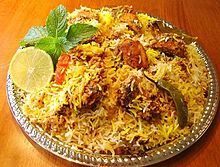
The city of Dhaka in Bangladesh is known for selling Chevon Biryani, a dish made with highly seasoned rice and goat meat. The recipe includes: highly seasoned rice, goat meat, mustard oil, garlic, onion, black pepper, saffron, clove, cardamom, cinnamon, salt, lemon, doi, peanuts, cream, raisins and a small amount of cheese (either from cows or buffalo). Haji biryani is a favourite among Bangladeshis living abroad.[43] A recipe was handed down by the founder of one Dhaka restaurant to the next generation. Haji Mohammad Shahed claimed, "I have never changed anything, not even the amount of salt".[44]
Dhakaiya Kacchi Biryani is accompanied by borhani, a salted mint drink made of yogurt, coriander, mint and salt.
Dindigul biryani[]
The Dindigul town of Tamil Nadu is noted for its biryani, which uses a little curd and lemon juice for a tangy taste.[45]
Hyderabadi biryani[]

Hyderabadi biryani is India's most famous biryani; some say biryani is synonymous with Hyderabad.[46] The crown dish of Hyderabadi Cuisine, Hyderabadi biryani developed under the rule of Asaf Jah I, who was first appointed as the governor of Deccan by the Mughal Emperor Aurangzeb. It is made with basmati rice, spices and goat meat. Popular variations use chicken instead of goat meat. There are various forms of Hyderabadi biryani, such as kachay gosht ki biryani or dum biryani, where goat meat is marinated and cooked along with the rice. It is left on a slow fire or dum for a fragrant and aromatic flavour.[47]
Memoni/Kutchi biryani[]
Memoni biryani is an extremely spicy variety developed by the Memons of Gujarat-Sindh region in India and Pakistan.[18] It is made with mutton, dahi, fried onions, and potatoes, and fewer tomatoes compared to Sindhi biryani. Memoni biryani also uses less food colouring compared to other biryanis, allowing the rich colours of the various meats and rice (and vegetables, if present) to blend without too much orange colouring.[citation needed]
Kalyani biryani[]
Kalyani biryani is a typical biryani from the former state of Hyderabad Deccan.[48] Also known as the "poor man's" Hyderabadi biryani, Kalyani biryani is always made from small cubes of buffalo meat.
The meat is flavoured with ginger, garlic, turmeric, red chili, cumin, coriander powder, and much onion and tomato. It is first cooked as a thick curry and then cooked along with rice. Then given dum (the Indian method of steaming in a covered pot).
Kalyani biryani is supposed to have originated in Bidar during the reign of the Kalyani Nawabs, who migrated to Hyderabad after one of the Nawabs, Ghazanfur Jang married into the Asaf Jahi family. Kalyani biryani was served by the Kalyani Nawabs to all of their subjects who came from Bidar to Hyderabad and stayed or visited their devdi or noble mansion.
Kolkata biryani[]

Calcutta or Kolkata biryani evolved from the Lucknow style, when Awadh's last Nawab Wajid Ali Shah was exiled in 1856 to the Kolkata suburb of Metiabruz.[18] Shah brought his personal chef with him. The Kolkata biriyani is characterized by the unique presence of potato in it, along with meat. It is said that the Nawab, having is lost his kingdom, could not afford meat, so his chefs tried to compensate by adding potato. But serious historians have rejected this as a myth. When Wajid Ali Shah arrived in Kolkata, potato was an exotic vegetable in India and the former Nawab of Awadh, being a connoisseur of great food encouraged their chefs to try new ingredients in the dish. The Kolkata biryani is much lighter on spices but high on flavours.
Rawther biryani[]
This type of biryani is popular in the Palakkad and Coimbatore regions. This was most commonly prepared by Rawther families in Kerala and Tamil Nadu. This type of biryani is cooked in a different style. Goat meat is most commonly used and it is entirely different from Malabar biryani.[citation needed]
Sindhi biryani[]

The exotic and aromatic Sindhi biryani is known in Pakistan for its spicy taste, fragrant rice and delicate meat. Sindhi biryani is a beloved staple in food menus of Pakistani and Sindhi cuisine. Sindhi biryani is prepared with meat and a mixture of basmati rice, vegetables and various spices. Sindhi biryani is often served by Pakistan International Airlines (PIA) on most of their international flights. A special version of Sindhi biryani sold by a shop in Karachi called the Students Center is popularly called "Students biryani."[49]
Sri Lankan biryani[]

Biryani was brought into Sri Lanka by the South Indian Muslims who were trading in the Northern part of Sri Lanka and in Colombo in the early 1900s.[citation needed] In Sri Lanka, it is Buryani, a colloquial word which generated from Buhari Biryani. In many cases, Sri Lankan biryani is much spicier than most Indian varieties. Side dishes may include acchar, Malay pickle, cashew curry and mint sambol.[citation needed]
Thalassery biryani[]

Thalassery biryani is the variation of biryani found in the Indian state of Kerala. It is one of the many dishes of the Malabar Muslim community, and very popular.[50]
The ingredients are chicken, spices and the specialty is the choice of rice called khyma. Khyma rice is generally mixed with ghee. Although a large number of spices such as mace, cashew nuts, sultana raisins, fennel-cumin seeds, tomato, onion, ginger, garlic, shallot, cloves and cinnamon are used,[51] there is only a small amount of chili (or chili powder) used in its preparation.
A pakki biryani, the Thalassery biryani uses a small-grained thin (not round) fragrant variety of rice known as khyma or jeerakasala. The dum method of preparation (sealing the lid with dough [maida] or cloth and placing red-hot charcoal above the lid) is applied here.
Outside the Indian subcontinent[]
Burma[]
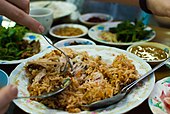
In Myanmar (Burma), biryani is known in Burmese as danpauk or danbauk (ဒံပေါက်), derived from the Persian term dum pukht, which refers to a slow oven cooking technique. Danbauk is a mainstay at festive events such as Thingyan, weddings and donation feasts.[52][53] Given danbauk's South Asian origins, danbauk restaurants and chains have traditionally been owned by Muslims, but in recent decades Buddhist entrepreneurs have entered the market.[52]
Featured ingredients include: cashew nuts, yogurt, raisins and peas, chicken, cloves, cinnamon, saffron and bay leaf cooked in long-grain rice.[54] In danbauk, chicken specially seasoned with a danbauk masala spice mix,[55] is cooked with the rice.[56] Danbauk is typically eaten with a number of side dishes, including a fresh salad of sliced onions, julienned cabbage, sliced cucumbers, fermented limes and lemons, fried dried chilies, and soup.[57] In recent decades, danbauk restaurants have innovated variations, including "ambrosia" biryani (နတ်သုဓာထမင်း), which features dried fruits and buttered rice.[57]
Western Asia[]
In Iraq and in the states of the Persian gulf, biryani (برياني: "biryani") is usually saffron-based with chicken usually being the meat or poultry of choice. It is popular throughout Iraq especially in Iraqi Kurdistan. Most variations also include vermicelli, fried onions, fried potato cubes, almonds and raisins spread liberally over the rice.[18] Sometimes, a sour/spicy tomato sauce is served on the side (maraq).
In Iran, during the Safavid dynasty (1501–1736), a dish called Berian (Nastaliq script: بریان پلو) was made with lamb or chicken, marinated overnight—with yogurt, herbs, spices, dried fruits like raisins, prunes or pomegranate seeds—and later cooked in a tannour oven, then served with steamed rice.[citation needed]
Afghan biryani[]
A different dish called biryan is popular in Afghanistan. Biryan traces its origins to the same source as biryani, and is today sold in Afghanistan as well as in Bhopal, India. Biryan is prepared by cooking gosht and rice together, but without the additional gravy (yakhni) and other condiments that are used in biryani. The Delhi-based historian Sohail Hashmi refers to the biryan as midway between pulao and biryani. Afghani biryani tends to use much dry fruit such as raisins and lesser amounts of meat, often cut into tiny pieces.[21]
Indonesia[]

Nasi kebuli is an Indonesian spicy steamed rice dish[58] cooked in goat meat broth, milk and ghee.[59] Nasi kebuli is descended from kabuli palaw which is an Afghani rice dish, similar to biryani served in the Indian subcontinent.[60]
Although Indonesia has authentic nasi kebuli, Indonesia also inherited and has local-style of biryani which known as nasi biryani or nasi briyani. Nasi biryani is popular among and often associated as Acehnese, Arab Indonesian, Indian Indonesian and Malay cuisine.[61]
Malaysia and Singapore[]
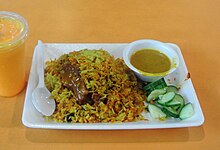
Nasi briyani dishes are very popular in Malaysia and Singapore. As an important part of Malaysian Indian cuisine, they are popularized through mamak stalls, hawker centres, and food courts as well as fine dining restaurants.
Mauritius[]
Biryani dishes are very popular in Mauritius especially at Hindu and Muslim weddings. It is also widely available at street food places.
Philippines[]
Kapampangan cuisine of the Philippines (often in Pampanga) features a special dish called nasing biringyi (chicken saffron rice), that is typically prepared only during special occasions such as weddings, family get-togethers or fiestas. It is not a staple of the Filipino diet as it is difficult to prepare compared to other usual dishes. Nasing biringyi is similar to the nasi briyani dish of Malaysia in style and taste. A version that has merged with the Filipino version of the Spanish paella is known as bringhe.[62]
South Africa[]
In the Cape Malay culture, a variation of biryani incorporates lentils as a key ingredient in the dish along with meat (usually beef, chicken, seafood or vegetables). The dish is made by cooking the rice and legumes and meat and gravy separately, then mixing it. Uncommonly, it is made using the dum-cooking method. The spices are similar to those used in the original Indian biryani.
Thailand[]

Biryani in Thailand is commonly known as khao mhok (Thai: ข้าวหมก). It is commonly paired with chicken, beef or even fish and topped with fried garlic. The dish is common in Thai cuisine and often served with a green sour sauce.
Turkey[]
This section is empty. You can help by . (May 2021) |
Tehari[]
Tehari and tehri are names for a vegetarian dish similar to biryani. It was developed for the Hindu bookkeepers of the Muslim Nawabs. It is prepared by adding the potatoes to the rice, as opposed to the case of biryani, where the rice is added to the meat. In Kashmir, tehari is sold as street food. Tehari became more popular during World War II, when meat prices increased substantially and potatoes became the popular substitute in biryani.
See also[]
- List of rice dishes
- Tehari
References[]
- ^ Karan, Pratibha (2012). Biryani. Random House India. ISBN 978-8-18400-254-6.
- ^ Gahlaut, Kanika (22 March 2015). "Food racism: Biryani to target Muslims?". DailyO. Retrieved 14 July 2016.
- ^ Sanghvi, Vir (27 February 2010). "Everything you want to know about biryani". Hindustan Times. Retrieved 14 July 2016.
- ^ Bhandari, Kabir Singh (21 April 2020). "The curious case of potato in Kolkata biryani and how the British fed us a lie". Hindustan Times. Retrieved 19 August 2020.
- ^ Wallis, Bruce (12 April 2017). "Eat My Words: A taste of Iraqi Kurdistan". Duluth News Tribune.
- ^ Naqvī, Ṣādiq; Rao, V. Kishan; Satyanarayana, A. (2005). A thousand laurels—Dr. Sadiq Naqvi: studies on medieval India with special reference to Deccan. 1. Felicitation Committee, Dept. of History & Dept. of Ancient Indian History, Culture & Archaeology, Osmania University. p. 97.
- ^ de Laet, Siegfried J. (1994). History of Humanity: From the seventh to the sixteenth century. UNESCO. p. 734. ISBN 978-9-23102-813-7.
- ^ Jump up to: a b c Karan, Pratibha (2009). Biryani. Random House India. pp. 1–12, 45. ISBN 978-81-8400-254-6.
- ^ "Definition of 'biryani'". Oxford Dictionary. Retrieved 15 July 2016.
- ^ Cannon, Garland Hampton; Kaye, Alan S. (2001). The Persian Contributions to the English Language: An Historical Dictionary. Otto Harrassowitz Verlag. p. 71. ISBN 978-3-44704-503-2.
- ^ Vishal, Anoothi (14 May 2011). "When rice met meat". Business Standard. Retrieved 6 August 2018.
- ^ Knipple, Paul; Knipple, Angela (March 2012). The World in a Skillet: A Food Lover's Tour of the New American South. ISBN 9780807869963.
- ^ Saxena, Sparshita. "10 Best Biryani Recipes". NDTV Food. Retrieved 24 June 2016.
- ^ Collingham, Lizzie (6 February 2006). Curry: A Tale of Cooks and Conquerors. Oxford University Press. p. 27. ISBN 978-0-19-988381-3.
- ^ Dhillon, Kris (2013). The New Curry Secret. Little, Brown Book Group. p. 234. ISBN 978-0-7160-2352-4.
- ^ Jump up to: a b c d Sanghvi, Vir. "Biryani Nation". Archived from the original on 17 August 2014. Retrieved 24 August 2014.
- ^ Jump up to: a b Padmanabhan, Mukund; Jeyan, Subash; Wilson, Subajayanthi (26 May 2012). "Food Safari: In search of Ambur biryani". The Hindu. Archived from the original on 18 October 2012. Retrieved 6 August 2018.
- ^ Jump up to: a b c d e Ganapti, Priya (9 April 2004). "Of biryani, history and entrepreneurship". Rediff.com. Retrieved 27 August 2014.
- ^ "Rude Food by vir Sanghvi: The people's biryani". 25 July 2021.
- ^ Jump up to: a b c Shaffer, Holly (2012). "6: Dum Pukht". In Ray, Krishnendu; Srinivas, Tulasi (eds.). Curried Cultures: Globalization, Food, and South Asia. University of California Press. pp. 124–. ISBN 978-0-520-27011-4.
- ^ Jump up to: a b c d e Ravish Kumar interviews historian Sohali Hashmi (9 September 2016). प्राइम टाइम : क्या-क्या अलग करेंगे बिरयानी से? [Prime Time: What will separate from Biryani?] (Television production) (in Hindi). Old Delhi: NDTV. Retrieved 19 October 2016.
- ^ Taylor Sen, Colleen (2014). Feasts and Fasts: A History of Food in India. Reaktion Books. pp. 194–195. ISBN 9781780233918.
- ^ Bhatnagar, Sangeeta; Saxena, R. K. (1 January 1997). Dastarkhwan-e-Awadh. HarperCollins Publishers, India. ISBN 978-81-7223-230-6.
- ^ Sharar, ʻAbdulḥalīm (1989) [1913]. Lucknow: The Last Phase of an Oriental Culture (Hindustan Men Mashriqi Tamaddun ka Akhri Namuna). Translated by E.S. Harcourt; Fakhir Hussain. Oxford University Press. ISBN 978-0-19-562364-2.
- ^ Makhijani 2017-06-22T10:00:00-04:00, Pooja. "A Beginner's Guide to Biryani, the Ultimate Rice Dish". Saveur. Retrieved 19 December 2018.
- ^ Jump up to: a b c Brown, Ruth (17 August 2011). "The Melting Pot – A Local Prep Kitchen Incubates Portland's Next Generation of Food Businesses". Willamette Week. 37 (41).
- ^ Makhijani 2017-06-22T10:00:00-04:00, Pooja. "A Beginner's Guide to Biryani, the Ultimate Rice Dish". Saveur. Retrieved 19 December 2018.
- ^ Isam, Mohammad. "The king of rice dishes". ESPN Cricinfo. Retrieved 6 August 2018.
- ^ "Dhaka's Biryani - A Taste of Aristocracy". NIBiz Soft. 23 May 2015. Retrieved 6 August 2018.
- ^ Bipul, Hassan (28 March 2016). "Dhaka's biryani can be UNESCO world heritage, says food critic Matt Preston". Bdnews24.com. Retrieved 6 August 2018.
- ^ "Where does biryani come from?". Hindustan Times. Archived from the original on 24 June 2016. Retrieved 20 October 2016.
- ^ "Easy chicken Biriyani Recipe". Viralvidos.com. 3 February 2017. Retrieved 6 August 2018.
- ^ Balachandran, Mohit (24 August 2015). "The Other Hyderabadi Biryani With a 300-Year-Old Past". NDTV. Retrieved 6 August 2018.
- ^ Nanisetti, Serish (4 November 2015). "A tale of two biryanis". The Hindu. Retrieved 6 August 2018.
- ^ Dhara, Tushar (10 June 2015). "Why Kalyani Beef Biryani Is a Favourite of Many Hyderabadis, Muslim and Hindu". The Huffington Post. Retrieved 6 August 2018.
- ^ Lal, Amrith (25 December 2015). "In fact: How beef became Malayalis' object of desire". The Indian Express. Retrieved 6 August 2018.
- ^ Kumar, K. C. Vijaya (16 March 2013). "In search of Bhatkal Biryani". The Hindu. Retrieved 6 August 2018.
- ^ Nath, Parshathy J. (23 June 2016). "All the way from Karaikudi". The Hindu. Retrieved 19 January 2017.
- ^ Verma, Rahul (1 August 2014). "Little Chettinad in East Delhi". The Hindu. Retrieved 19 January 2017.
- ^ "Delicious destinations: From Dindigul biryani to Bikaneri bhujia". The Indian Express. 14 June 2016. Retrieved 19 January 2017.
- ^ Kannadasan, Akila (12 July 2016). "When Hyderabad came to Chennai". The Hindu. Retrieved 19 January 2017.
- ^ Karan, Pratibha (2009). Biryani. Random House (India). ISBN 978-8184000931.
- ^ Sakhawat, Adil (8 March 2013). "Haji Biriyani: The Scintillating Taste from Old Dhaka". Daily Sun. Archived from the original on 18 May 2015. Retrieved 30 April 2015.
- ^ Mydans, Seth (8 July 1987). "For A Secret Stew Recipe, Time Is Running Out". The New York Times. Retrieved 30 April 2015.
- ^ "Biryani bistro". The Hindu. 11 March 2010. Retrieved 28 December 2012.
- ^ "10 Cities in India for the Food Lover's Soul". India.com. 5 December 2014. Retrieved 26 July 2016.
- ^ "India's Best City For Biryani Is..." The Wall Street Journal. 14 April 2013. Retrieved 16 May 2016.
- ^ "Stuff of memories". The Hindu. 10 February 2008. Archived from the original on 16 February 2008. Retrieved 6 August 2018.
- ^ Tribune.com.pk (28 November 2011). "By word of mouth: Student Biryani goes global". The Express Tribune. Retrieved 24 May 2019.
- ^ Karan, Pratibha (2012). Biryani. Random House India. ISBN 978-8-18400-254-6.
- ^ Abdulla, Ummi (1993). Malabar Muslim Cookery. Orient Blackswan. p. 2. ISBN 978-8125013495.
- ^ Jump up to: a b "Biryani trade takes on a new flavour". The Myanmar Times. 20 March 2015. Retrieved 25 April 2020.
- ^ "Mouth-watering Thingyan food and delicacies". The Myanmar Times. 6 April 2018. Retrieved 25 April 2020.
- ^ "ဒံပေါက် (Biryani)". Food Magazine Myanmar (in Burmese). 12 September 2019. Retrieved 25 April 2020.
- ^ "ကြက်သားဒံပေါက်". Food Magazine Myanmar. Retrieved 25 April 2020.
- ^ Pham, Mai (11 October 2000). "The Burmese Way / A visit to the land of pagodas and enchanting cuisine". The San Francisco Chronicle.
Burmese chicken biryani differs from its Indian counterpart: the chicken is cooked with the rice.
- ^ Jump up to: a b "Top 10: Biryani Restaurants in Yangon". The Myanmar Times. 3 January 2020. Retrieved 25 April 2020.
- ^ "Nasi Kebuli Gaya Betawi". Kompas (in Indonesian). 21 February 2009. Retrieved 30 January 2015.
- ^ Dharmaputra, T.S. (2015). Kumpulan Masakan Favorit Sepanjang Masa (in Indonesian). Jakarta: Puspa Swara. ISBN 978-602-213-036-9. Retrieved 5 June 2017.
- ^ Galpin, Shannon (2014). Mountain to Mountain: A Journey of Adventure and Activism for the Women of Afghanistan. Macmillan. ISBN 978-1-250-04664-2.
- ^ "Sajian Kebuli, Mandi, dan Biryani". Kompas.com (in Indonesian). 6 July 2014. Archived from the original on 3 September 2014. Retrieved 24 August 2014.
- ^ "Come Taste My Philippines – the food of Pampanga". A Bouche Amused. 16 January 2012. Retrieved 20 February 2018.
External links[]
- Andhra cuisine
- Bahraini cuisine
- Bangladeshi rice dishes
- Beef dishes
- Bengali cuisine
- Burmese cuisine
- Desi culture
- Fish dishes
- Gujarati cuisine
- Hyderabadi cuisine
- Mauritian cuisine
- Indian chicken dishes
- Indian meat dishes
- Indian rice dishes
- Indonesian rice dishes
- Iraqi cuisine
- Kurdish cuisine
- Kuwaiti cuisine
- Lamb dishes
- Malaysian cuisine
- Muhajir cuisine
- Pakistani rice dishes
- Punjabi cuisine
- Sindhi cuisine
- Singaporean cuisine
- Sri Lankan chicken dishes
- Sri Lankan lamb dishes
- Sri Lankan rice dishes
- Tamil cuisine
- Telangana cuisine
- Chicken and rice dishes
- Nepalese cuisine





